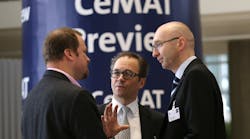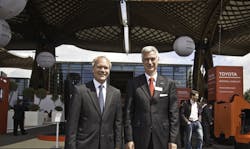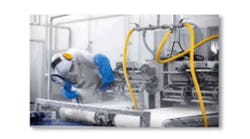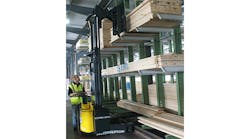As you’ll see in the CeMAT gallery we just posted, executives from diverse parts of their own companies got a chance to strategize about how they can collaborate to take advantage of developing international markets. That happened at the industry level as well as the company level. For example, CeMAT offered the perfect stage from which to announce a World Materials Handling Alliance, launched by BMHRI (representing China's materials handling machinery industry), CMES (the Chinese Mechanical Engineering Society), FEM (the European Materials Handling Federation), JIMH (the Japan Institute of Material Handling), and, of course, U.S.-based MHI.
Through this alliance, these organizations committed to enhancing cooperation on issues of mutual interest. They’ll share information on markets (publicly available data on production and trade of materials handling equipment) and on regulatory requirements and standards for placing equipment on the market. They will also exchange information on trends that influence the application of material handling solutions throughout the world, the Alliance stated in their announcement.
Lift truck OEMs offered a fascinating and huge microcosm through which to examine this call to globalism. Rolf Eiten, chief operating officer for CLARK Europe GmbH, said his company would use CeMAT to establish contact with potential new dealers so it could grow its global presence. In doing so, however, the company intends to maintain a high standard for service and safety.
“We have extended our training for vendors and service technicians in particular,” he said. “New training courses such as the ‘Expert examination for LPG systems’ and the ‘Annual Safety Inspection according to FEM 4.004’ improve the profile of our service technicians in the long term, and our dealers are able to draw up additional business by maintaining high safety standards.”
Toyota’s material handling CEOs are also collaborating to improve their respective safety and productivity offerings. Brett Wood, president and CEO of Toyota Material Handling North America (below, left) and Matthias Fischer, president & CEO of Toyota Material Handling Europe, told MH&L how they are addressing these priorities.“The biggest difference in safety between U.S. and Europe might be more on the ergonomic side,” Fischer said. “There are studies showing long-range costs of vibration, for example. Having cab heating and cooling is also more important in Europe than in the U.S. A couple years ago the emphasis was on productivity and speed. Now the emphasis is on a safe environment.
Wood agreed.
“Safety is now more important because our customers have to be good corporate citizens as well,” he said. “Safety can even extend to the power source. For example, lithium ion batteries replacing lead acid could make a contribution to the environment. It’s being tested now and could be in a race to market with fuel cells. Changing heavy lead acid batteries must be done carefully to avoid any safety issues.”
Tires play an important role in safety too, and tire supplier Trelleborg was hoping to use its CeMAT presence to send that message to potential partners as much as to end users. That means educating the markets on tire efficiency and safety, said Trelleborg's James Pick, marketing communications director.
“We replace 200,000 solid tires a year through our service business,” he said. “We did a Europe-wide survey and found that on average people throw away 25% of their tire life. That’s 25% of your tire spend wasted. We also discovered 3% continue to use their tires beyond the point when they’re safe. When you think about how many thousands of lift trucks there are in daily use. That’s a lot of trucks that don’t have sufficient traction to grip when turning corners. Sudden slipping under heavy load can cause serious injury.”
One of the most eye-catching demonstrations at the CeMAT show from a lift truck perspective came from STILL, better known in the U.S. through its affiliation with the Kion Group, which includes Linde. It demonstrated the six-in-one Transformer-like Cube XX, a concept truck that’s more of a demonstration of possibilities than of a product. Bert-Jan Knoef, CEO of Still, used his company’s presence at CeMAT as an opportunity to address the importance of operator safety. He said that while the Cube XX is flexible enough to change from a pallet truck to a rider to a stacker to a double stacker, the challenge with it is the same for any lift truck: training.
“Having one truck with different configurations will be a challenge for our distributors and our customers,” he said. “The customer users will have to be open for a little more complicated system. They’ll need different training and a different background, not just as a standard operator.”
Still also showed a new kind of training via its iGo Easy system, using iPad based control of an automated warehouse truck. Visitors sat in a virtual cockpit while real-time images were displayed via a three-dimensional interface. Knoef believes that with industry innovations like this, safety on the job will increase.
Take a look at the CeMAT photo gallery we just posted for an even deeper dive into how the world is changing material handling—or is it the other way around?





